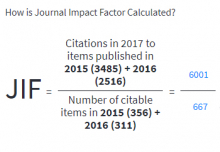Scientometrics: ranking and comparingContents Main bibliometric terms (h-index, impact factor etc) Analytical tools (SciVal, InCites etc) Citation databasesScopus (Elsevier, Netherland) is the largest abstract and citation database of peer-reviewed literature: scientific journals, books and conference proceedings. Web of Science Core Collection Web of Science Core Collection (Clarivate Analytics, USA) is the world's most trusted citation index for scientific and scholarly research and a curated collection of high quality scholarly content. RISC Russian Science Citation Index (RSCI) on the platform of eLIBRARY.RU
Main bibliometric terms (h-index, impact factor, etc.)
The Journal Impact Factor identifies the frequency with which an average article from a journal is cited in a particular year. You can use this number to evaluate or compare a journal’s relative importance to others in the same field or see how frequently articles are cited to determine which journals may be better for your collection.
Journal lists and rankingsSJR SCImago Journal & Country Rank is a publicly available portal that includes the journals and country scientific indicators developed from the information contained in the Scopus database (Elsevier B.V.). SNIP (Source Normalized Impact per Paper). Source Normalized Impact per Paper (SNIP) measures contextual citation impact by weighting citations based on the total number of citations in a subject field. JCR (Journal Citation Reports). Journal Citation Reports presents quantifiable statistical data that provides a systematic, objective way to evaluate the world’s leading journals and their impact and influence in the global research community. JCR is available in two editions. The Science Edition covers over 5,900 international science journals from the Web of Science Core Collection database. The Social Sciences Edition covers over 1,700 leading international social sciences journals from the Web of Science Core Collection database. Journal Citation Reports: Journal Profile Quick Tour Discontinued sources from Scopus July 2019 Russian journals list in Scopus
Analytical tools (SciVal, InCites, etc.)SciVal (Elsevier) SciVal allows you to visualize your research performance, benchmark relative to peer institutions, develop strategic partnerships, identify and analyze new, emerging research trends, and create uniquely tailored reports. InCites (Clarivate Analitics) InCites is a customized, web-based research evaluation tool that can help you develop your research strategy. InCites allows you to analyze institutional productivity, monitor collaboration activity, identify influential researchers, showcase strengths, and discover areas of opportunity. Essential Science Indicators (Clarivate Analitics) Essential Science Indicators (ESI) is an analytical tool that helps you identify top-performing research in Web of Science Core Collection. |











